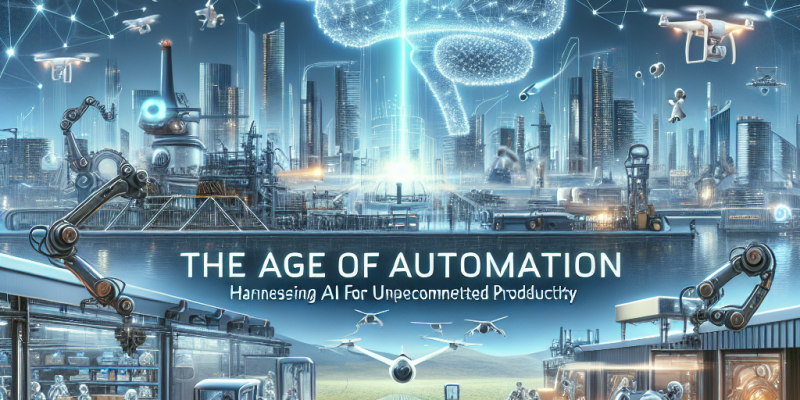The Age of Automation: Harnessing AI for Unprecedented Productivity

As we stand at the brink of a new era defined by rapid technological advancements, we find ourselves enveloped in what many are calling "The Age of Automation." This transformative period is characterized by the emergence of Artificial Intelligence (AI) and automation technologies that are reshaping industries, redefining labor, and altering the very fabric of our daily lives. The potential for unprecedented productivity gains through harnessing AI is immense, but it also comes with challenges that society must navigate cautiously.
The Rise of AI and Automation
Automation has long been part of our industrial landscapes, from the simple machines of the Industrial Revolution to the sophisticated robotics used today in manufacturing. However, the advent of AI has marked a paradigm shift. Unlike traditional automation, which is primarily rule-based and restricted in its ability to adapt or learn, AI systems can analyze vast datasets, learn from patterns, and make predictions, enabling them to optimize processes dynamically.
Today, AI is not limited to manufacturing; it is making waves in fields as diverse as healthcare, finance, logistics, and customer service. Intelligent chatbots, automated diagnostic tools, predictive analytics, and autonomous vehicles are just a few examples of how AI is increasingly becoming integral to various sectors. As these technologies evolve, they promise to enhance efficiency, reduce costs, and improve accuracy, thereby contributing to a remarkable uptick in productivity.
Unprecedented Productivity Gains
The benefits of AI and automation are manifold. Here are a few ways they are paving the path for unparalleled productivity:
1. Streamlined Operations
AI can analyze data in real time and offer insights that help businesses streamline their operations. Predictive maintenance, for example, uses machine learning algorithms to predict equipment failures before they occur, minimizing downtime and increasing operational efficiency.
2. Enhanced Decision-Making
AI technologies can sift through immense datasets to uncover trends and insights that humans may overlook. This capability facilitates data-driven decision-making across all levels of an organization, leading to more informed strategies and improved outcomes.
3. Increased Employee Productivity
By taking over repetitive and mundane tasks, AI enhances employee productivity. Automation frees workers to focus on more strategic, creative, and analytical tasks, allowing them to leverage their unique skills and drive innovation.
4. Better Customer Experience
AI-powered tools such as chatbots can provide instant support to customers, effectively managing high volumes of inquiries. This not only improves customer satisfaction but also allows businesses to optimize their resources and respond swiftly to market demands.
5. Enhanced Scalability
AI allows organizations to scale operations seamlessly. Companies can adapt to fluctuating market demands without the need for proportional increases in labor, thereby amplifying productivity while maintaining cost-effectiveness.
Challenges and Considerations
While the potential for productivity gains through AI and automation is staggering, it is essential to approach this revolution with critical foresight. Some of the significant challenges include:
1. Workforce Displacement
As machines increasingly take over tasks traditionally performed by humans, concerns around job displacement are valid. While new opportunities will emerge, there will be a transitional period that may leave many workers vulnerable. It is imperative for businesses and policymakers to prioritize workforce reskilling and upskilling initiatives.
2. Ethical Considerations
AI implementation brings forth ethical dilemmas regarding data privacy, algorithmic bias, and decision-making transparency. Organizations must be dedicated to ethical AI practices to foster trust and mitigate potential societal inequalities.
3. Security Risks
Automating processes can expose organizations to cybersecurity threats. As dependency on AI and automation grows, so does the critical need for robust cybersecurity measures to safeguard sensitive information.
Conclusion: Embracing the Future
The Age of Automation, driven by AI, holds the promise to redefine productivity across industries. With the potential to unlock significant operational efficiencies, enhance decision-making, and improve customer experience, businesses that harness these technologies stand to benefit enormously. However, navigating the accompanying challenges with sensitivity and foresight is essential to ensure a future that is equitable and sustainable for all.
Ultimately, we are tasked with not just embracing technological advancements but doing so responsibly. As we embark on this new journey, collaboration among businesses, governments, educational institutions, and society at large will be key to navigating this transformative landscape. Embracing the Age of Automation is not merely about enhancing productivity; it is about evolving as a society that leverages technology for the betterment of all.














